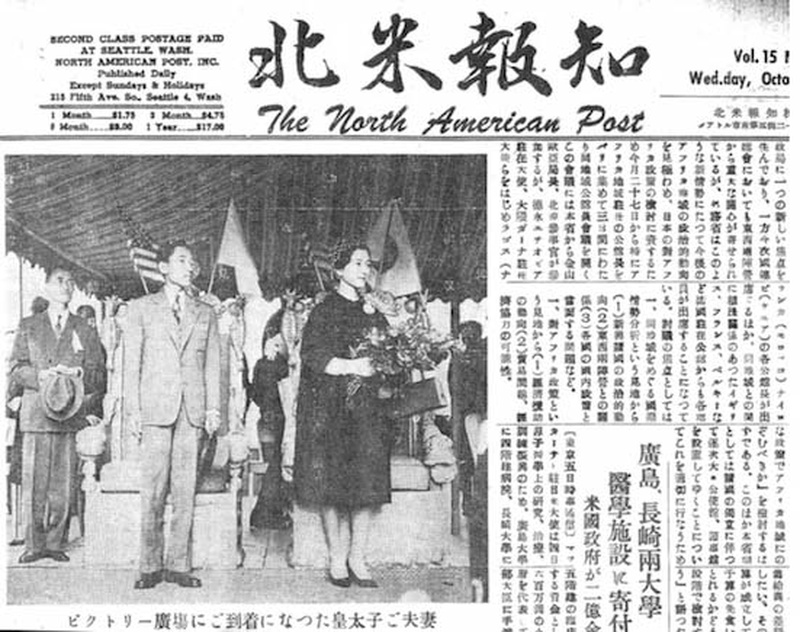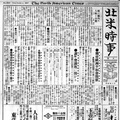A noticeboard for a community anxious about its safety
The compulsory expulsion of Nikkei during World War II had all but wiped out the Japanese American presence in Japantown. After the war, as people were released from the camps, they restarted their lives. Japanese-language media started to appear, and in June 1946, a publication that continues today, Hokubei Hochi, was published by Hochi Shinbun.
The editor in chief was the same person who published Hokubei Jiji before the war, Sumio Arima. The publisher was the former editor of the Takoma Jijo, Sadahiko Ikoma. He is the grandfather of Elaine Ikoma Ko, Today’s secretary-general of the Hokubei Hochi Foundation.
The word “hochi” took on the meaning of a noticeboard where Japanese Americans returning from the camps could watch out for each other. Arima had this to say about restarting the Jiji media business:
What is that person up to? What are those people trying to do? Even if you wanted to know, there was no way to find out. A half year had passed since we identified the need for some sort of news media. We figured we could put out temporarily a weekly publication that shared regional news, and that was Hokubei Hochi.
The office was on 6th Avenue in Nihonmachi. At first, it was an eight-page tabloid that came out once a week, but by 1948, it was published three times a week, and by the following year, it was coming out six times a week. More people were returning from Japan, increasing the readership and the advertising base, and strengthening the Nikkei community once again.
Visits by the Royal Family and Prime Minister
In 1960, the Crown Prince and Princess (today’s Emperor and Empress) visited Seattle. The paper reported in its October 5 edition that 1,000 people went to the airport to greet them. For days after, Japanese companies celebrated the arrival of the guests. And in 1975, the paper did a special on the Seattle visit of Prime Minister Takeo Miki, which was picked up by the Yomiuri Shimbun.
The paper covered the history of Nikkei immigrants through a column called “Nihon Tayori” by author Kazuo Ito. It also ran community news, notices, obituaries, and reports from Tacoma, Spokane, and Portland. The paper published literary works including serialized novels, haiku and tanka poems. Ads from shipping companies, travel agencies, shops, beauty salons, restaurants, Nikkei businesses as well as playhouses, movie theaters, and cultural organizations filled the pages.
During the 1970s, the Issei readers began to grow old, and the paper reduced its print runs. Rising postal rates also squeezed the business. The business faced the possibility of going out of business, but strong support from the community saved it from that fate. In 1974, it received donations from supporting organizations, and in 1981, it stopped publishing for three months, prompting the formation of the North American Post Publishing Co. by a group of supporting Nikkei organizations to ensure the paper could continue publishing.
Rebirth of North American Post Publishing
In October 1983, the office moved to Jackson Street. Advances in printing made it possible to move from the old-fashioned type-setting to typing the articles directly in Japanese. The Japanese word processor appeared around this time, and headlines were set with a photo-typesetter. The editorial staff and the readers were now largely drawn from the postwar immigrants, known as the New Issei.
In 1988, the community felt historic meaning in the redress movement adopted by the US government. Tomio Moriguchi, then CEO of Uwajimaya, took over as publisher of Hokubei Hochi. At the Seattle convention of the Japanese American Citizens League, Hokubei Hochi announced that it would print a sister publication in English every month called Northwest Nikkei. That paper was folded into the bilingual Hokubei Hochi in 2004 and continues to be published today in that form. The monthly business paper BZ Japan was also launched, and in 2002, a centennial anniversary edition celebrated the birth of the Hokubei Jiji.
In 1995, the computerized system of publishing used today was adopted. In 2005, the paper became a free paper, and in 2010, color was added to parts of the paper. In 2001, the offices were moved from Jackson Street to the old Uwajimaya building. When the restoration of the Publix Building began, the offices moved to a nearby one-story building.
Publication of the newspaper slowed to its current pace of once a week, but for 71 years, the bilingual 16-page paper has continued to come out.
* This article was orinally published in The North American Post on June 22, 2017.
© 2017 The North American Post






